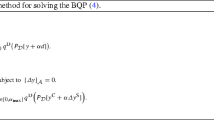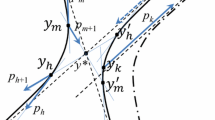Abstract
We compare the projective methods for linear programming due to de Ghellinck and Vial, Anstreicher, Todd, and Fraley. These algorithms have the feature that they approach feasibility and optimality simultaneously, rather than requiring an initial feasible point. We compare the directions used in these methods and the lower-bound updates employed. In many cases the directions coincide and two of the lower-bound updates give the same result. It appears that Todd's direction and Fraley's lower-bound update have slight advantages, and this is borne out in limited computational testing.
Similar content being viewed by others
References
I. Adler, N. Karmarkar, M. G. C. Resende, and G. Veiga, An implementation of Karmarkar's algorithm for linear programming,Mathematical Programming 44 (1989), 297–335.
K. M. Anstreicher, A monotonie projective algorithm for fractional linear programming,Algorithmica 1 (1986), 483–498.
K. M. Anstreicher, A combined phase I-phase II projective algorithm for linear programming,Mathematical Programming 43 (1989), 209–223.
K. M. Anstreicher and P. Watteyne, A family of search directions for Karmarkar's algorithm, Discussion Paper 9030, CORE, Catholic University of Louvain, Louvain-la-Neuve, 1990.
C. Fraley, Linear updates for a single-phase projective method,Operations Research Letters 9 (1990), 169–174.
C. Fraley and J.-P. Vial, Numerical study of projective methods for linear programming, in:Optimization, S. Dolecki, ed., Lecture Notes in Mathematics, Vol. 1405, Springer-Verlag, Berlin, 1989, pp. 25–38.
C. Fraley and J.-P. Vial, Single-phase versus multiphase projective methods for linear programming, Manuscript, COMIN, University of Geneva, May 1989.
R. Freund, A potential-function reduction algorithm for solving a linear program directly from an infeasible “warm start”,Mathematical Programming 52 (1991), 441–466.
D. Gay, A variant of Karmarkar's linear programming algorithm for problems in standard form,Mathematical Programming 37 (1987), 81–90.
G. de Ghellinck and J.-P. Vial, A polynomial Newton method for linear programming.Algorithmica 1 (1986), 425–453.
G. de Ghellinck and J.-P. Vial, An extension of Karmarkar's algorithm for solving a system of linear homogenous equations on the simplex,Mathematical Programming 39 (1987), 79–92.
P. E. Gill, W. Murray, M. A. Saunders, J. A. Tomlin, and M. H. Wright, On projected Newton barrier methods for linear programming and an equivalence to Karmarkar's projective method,Mathematical Programming 36 (1986), 183–209.
P. E. Gill, W. Murray, M. A. Saunders, and M. H. Wright, Shifted barrier methods for linear programming, Technical Report SOL 88-9, Department of Operations Research, Stanford University, July 1988.
C. Gonzaga, Search directions for interior linear programming methods,Algorithmica 6 (1991), 153–181.
C. Gonzaga, Conical projection algorithms for linear programming,Mathematical Programming 43 (1989), 151–173.
N. Karmarkar, A new polynomial time algorithm for linear programming,Combinatorica 4 (1984), 373–395.
M. Kojima, S. Mizuno, and A. Yoshise, A polynomial-time algorithm for a class of linear complementarity problems,Mathematical Programming 44 (1989), 1–26.
I. Lustig, Feasibility issues in an interior-point method for linear programming,Mathematical Programming 49 (1990/1991), 145–162.
I. Lustig, R. E. Marsten, and D. F. Shanno, Computational experience with a primal-dual interior-point method for linear programming,Linear Algebra and Its Applications 152 (1991), 191–222.
K. A. McShane, C. L. Monma, and D. Shanno, An implementation of a primal-dual interiorpoint method for linear programming,ORSA Journal on Computing 1 (1989), 70–83.
A. Steger, An extension of Karmarkar's algorithm for bounded linear programming problems, M.Sc. Thesis, SUNY at Stonybrook, NY, 1985.
M. J. Todd and B. P. Burrell, An extension of Karmarkar's algorithm for linear programming using dual variables,Algorithmica 1 (1986), 409–424.
M. J. Todd, Improved bounds and containing ellipsoids in Karmarkar's linear programming algorithm,Mathematics of Operations Research 13 (1988), 650–659.
M. J. Todd, On Anstreicher's combined phase I-phase II projective algorithm for linear programming,Mathematical Programming, to appear.
M. J. Todd, The effects of degeneracy and null and unbounded variables on variants of Karmarkar's linear programming algorithm, in:Large-Scale Numerical Optimization, T. F. Coleman and Y. Li, eds., SIAM, Philadelphia, PA, 1990, pp. 81–91.
J.-P. Vial, A unified approach to projective algorithms for linear programming, in:Optimization, S. Dolecki, ed., Lecture Notes in Mathematics, Vol. 1425, Springer-Verlag. Berlin, 1989, pp. 191–220.
Y. Ye and M. Kojima, Recovering optimal dual solutions in Karmarkar's polynomial algorithm for linear programming,Mathematical Programming 39 (1987), 305–317.
Author information
Authors and Affiliations
Additional information
Communicated by Nimrod Megiddo.
This research was partially supported by NSF Grant DMS-8904406 and by ONR Contract N00004-87-K0212. The computations were carried out in the Cornell Computational Optimization Laboratory with support from NSF Grant DMS-8706133.
Rights and permissions
About this article
Cite this article
Todd, M.J., Wang, Y. On combined phase 1-phase 2 projective methods for linear programming. Algorithmica 9, 64–83 (1993). https://doi.org/10.1007/BF01185339
Received:
Revised:
Issue Date:
DOI: https://doi.org/10.1007/BF01185339




